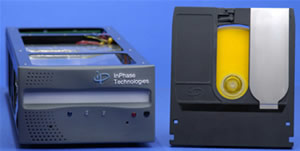
InPhase Technologies Starts Sampling Holographic Media
At CES 2006, InPhase is demonstrating compact holographic storage systems.
The technology behind the holographic storage was developed by IBM researchers a few years ago, were they built the first prototypes for the development of storing data using holograms.
At its basic, a blue-green laser similar to the one above is split into a reference and an object beam. The object beam, which is the carrier for the data is expanded to fully illuminate a spatial light modulator (SLM). An SLM is basically a LCD panel that displays a page of binary data represented by a grid of pixels being either on or off. An interference beam results from the laser passing through the SLM and is recorded on the media (originally photosensitive crystal).
Systems like the ones IBM worked with were enormous in size and required a great deal of power to operate. Today however, InPhase brings this technology down to the size of an average external storage drive with the media being no larger than a DVD-RAM cartridge.

InPhase is calling its media technology Tapestry and is currently developing and sampling three variants: Tapestry HDS3000 uses green laser to read and write while Tapestry HDS4000 uses red and Tapestry HDS5000 uses blue. The different wavelengths of the lasers allow for different storage capacities and InPhase has already been shipping out media to manufacturers for evaluation since Q4 of 2005.
InPhase will be the first company to deliver a holographic product for professional archive applications, in late 2006. The media for this product will be offered through its strategic partner, Hitachi Maxell Ltd.
Currently however, InPhase is only sampling a read only version of its discs called H-ROM media (Holographic-ROM).
The company says that initially, H-ROM discs will be able to hold 300GB of data on a 130mm disc and transfer at a rate of 20MB per second. The media will use the red laser because of pricing and availability until green and blue emitters come down in price.
At its basic, a blue-green laser similar to the one above is split into a reference and an object beam. The object beam, which is the carrier for the data is expanded to fully illuminate a spatial light modulator (SLM). An SLM is basically a LCD panel that displays a page of binary data represented by a grid of pixels being either on or off. An interference beam results from the laser passing through the SLM and is recorded on the media (originally photosensitive crystal).
Systems like the ones IBM worked with were enormous in size and required a great deal of power to operate. Today however, InPhase brings this technology down to the size of an average external storage drive with the media being no larger than a DVD-RAM cartridge.

InPhase is calling its media technology Tapestry and is currently developing and sampling three variants: Tapestry HDS3000 uses green laser to read and write while Tapestry HDS4000 uses red and Tapestry HDS5000 uses blue. The different wavelengths of the lasers allow for different storage capacities and InPhase has already been shipping out media to manufacturers for evaluation since Q4 of 2005.
InPhase will be the first company to deliver a holographic product for professional archive applications, in late 2006. The media for this product will be offered through its strategic partner, Hitachi Maxell Ltd.
Currently however, InPhase is only sampling a read only version of its discs called H-ROM media (Holographic-ROM).
The company says that initially, H-ROM discs will be able to hold 300GB of data on a 130mm disc and transfer at a rate of 20MB per second. The media will use the red laser because of pricing and availability until green and blue emitters come down in price.





















